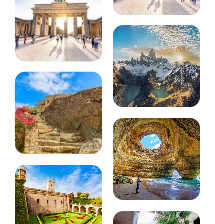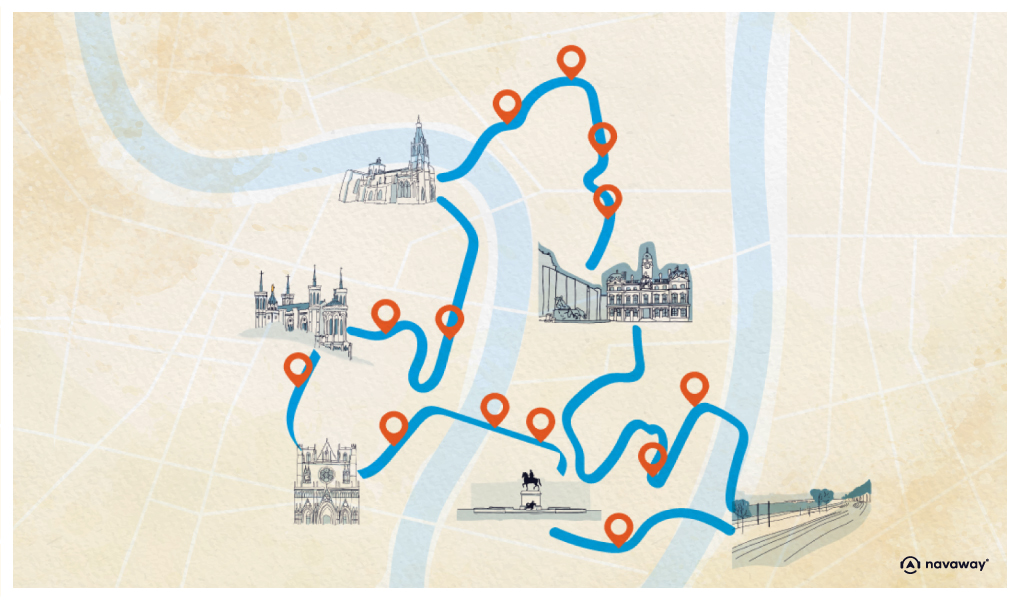
Visit the Basilica of Notre-Dame de Fourvière in Lyon
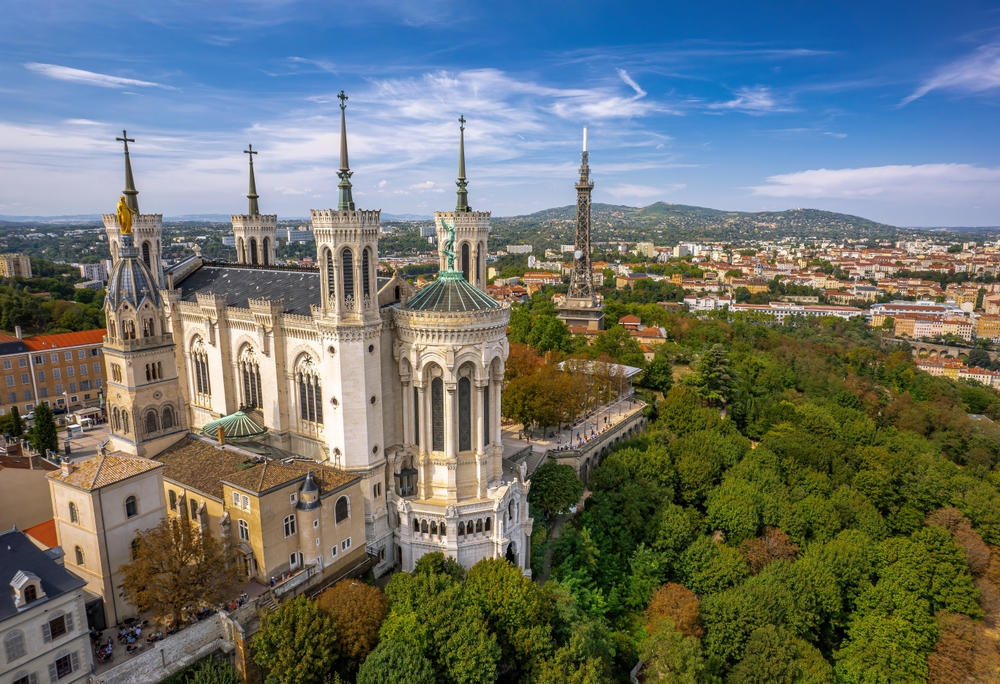
Perched on Fourvière hill, Notre-Dame de Fourvière Basilica has majestically dominated the city of Lyon since 1884. An emblematic monument listed as a UNESCO World Heritage Site, this sanctuary nicknamed the “upside-down elephant” by the people of Lyon fascinates visitors with its exceptional neo-Byzantine architecture, dazzling mosaics and breathtaking panorama. Whether you’re a history buff, an architecture enthusiast or just a visitor in search of wonders, this basilica promises an unforgettable experience in the heart of the capital of Gaul.

History and origins of the Basilica of Notre-Dame de Fourvière
The history of the Basilica of Notre-Dame de Fourvière is part of a Marian tradition that has been deeply rooted in Lyon since the Middle Ages. Long before the present building was constructed, the hill of Fourvière was already home to a modest chapel dedicated to the Virgin Mary, erected in the 12th century on the remains of the ancient Roman forum – hence the name “Fourvière”, a distortion of the Latin “Forum Vetus” meaning “old forum”.
The decision to build a monumental basilica emerged in a particular historical context. In 1870, when France was threatened by the Franco-Prussian war, the Lyonnais authorities made a solemn vow to build a Marian shrine if the city was spared. As Lyon escaped the Prussian invasion, the Lyonnais kept their promise. The first stone was laid on 7 December 1872, blessed by Pope Pius IX himself.
Under the direction of architect Pierre Bossan, a true visionary of recognised talent, the work was spread over twelve years. Bossan designed an exceptional building that harmoniously blended neo-Romanesque and neo-Byzantine styles, creating an architectural work that is unique in France. Unfortunately, the architect died in 1888, before completing his masterpiece. His pupil Louis Sainte-Marie-Perrin took over and completed the interior decoration, including the sumptuous mosaics for which the basilica is now world-famous.
Officially inaugurated in 1896, the Basilica of Notre-Dame de Fourvière quickly became the spiritual symbol of Lyon and a major place of pilgrimage. Its status as a minor basilica was granted in 1896 by Pope Leo XIII. Today, it attracts millions of visitors every year who come to admire this architectural jewel and enjoy the exceptional panoramic view over the city. When you visit Visit Lyon, make sure you don’t miss this must-see monument, which in itself tells the story of centuries of history and devotion.
See also the Lyon guide :
- What to do in Lyon Top 6 activities + Good tips
- Visit Lyon in 3 days: complete guide and itinerary
- Free activities in Lyon: 16 free visits and outings
- 9 exceptional Lyonnais bouchons to try
- 15 Must-Do Excursions Around Lyon
- 20 Essential Weekend Getaway Ideas Around Lyon
- The 10 Most Beautiful Bike Rides to Take in Lyon
Architecture and style of the Basilica of Fourvière

The architecture of Notre-Dame de Fourvière Basilica is a veritable hymn to 19th-century eclecticism. At first glance, the building impresses with its monumental silhouette that stands out in the Lyon landscape. Pierre Bossan designed a bold architectural ensemble that brilliantly blends Romanesque and Byzantine influences, creating a totally unique style.
The façade and the four symbolic towers
The main façade of the basilica is immediately striking for its rich ornamentation. Four octagonal towers majestically frame the building, each bearing a profound symbolism. These towers represent the four cardinal virtues dear to the Catholic Church: Prudence, Temperance, Strength and Justice. At the top of the north-west tower sits the famous golden statue of the Virgin Mary, 5.60 metres high and created by the sculptor Joseph-Hugues Fabisch. Visible from all over the city, this statue towers 47 metres above the ground, and over time has become one of the most recognisable symbols of Lyon.
The materials used reflect a desire for brilliance and durability: the white Lucenay stone contrasts elegantly with the multi-coloured glazed tile roofs, creating a striking visual effect reminiscent of Byzantine influences. The use of white Carrara marble for certain decorative elements adds a further touch of refinement to the whole.
Inside: a showcase of exceptional mosaics
Stepping through the doors of the basilica is like stepping into a world of unprecedented visual richness. The interior of the Basilica of Notre-Dame de Fourvière is divided into two levels: the upper church and the lower crypt. The upper church instantly dazzles visitors with its sumptuous mosaics covering more than 6,000 square metres. Created by Charles Lameire’s studio between 1884 and 1896, these mosaics depict the major episodes in the life of the Virgin Mary and illustrate the history of Marian worship in Lyon.
The gilded vaults glisten in the natural light streaming through the coloured stained glass windows, creating an atmosphere that is both solemn and magical. The four side chapels are each uniquely decorated with polychrome marble altars, delicate sculptures and wall paintings of remarkable finesse. Every architectural detail, from the floor to the ceiling, bears witness to exceptional craftsmanship and a desire to create a sacred space of absolute beauty.
St Joseph’s crypt: sober and contemplative
Located beneath the upper church, the Saint-Joseph crypt offers a striking contrast to the opulence of the upper floor. Completed in 1896, this vast underground chamber is characterised by a more restrained architecture, conducive to contemplation and prayer. Supported by numerous stone columns, the crypt regularly hosts religious celebrations in an intimate and soothing atmosphere. This is also where various relics are laid to rest and where certain daily masses are held, away from the crowds of tourists in the upper church.
Download the audio-guided tour to discover Lyon on foot and on your own
To make the most of your discovery of Lyon and its iconic monuments such as the Basilica of Fourvière, we strongly recommend that you use the Navaway audio tour to visit Lyon. This interactive tour will guide you through the city’s most beautiful districts, taking in 26 major places of interest with captivating audio commentary. You can explore the city at your own pace, understanding the rich history and culture of each site you visit. The app accompanies you step by step, giving you an immersive experience comparable to that of a private guided tour, but with the freedom to stop wherever you like.
What to see and do at the Basilique Notre-Dame de Fourvière
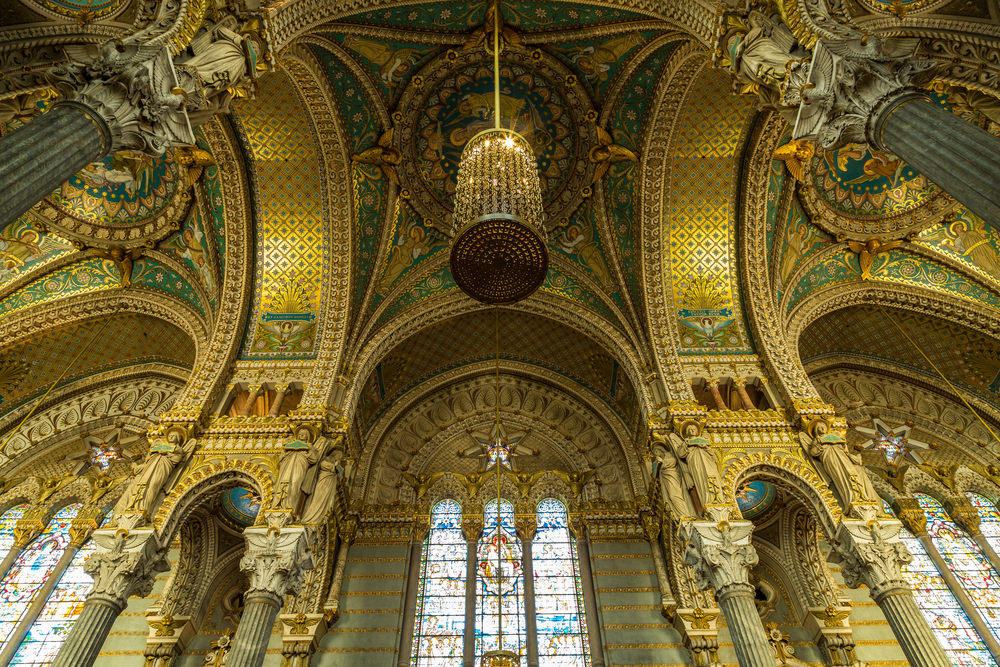
A visit to the Basilica of Notre-Dame de Fourvière has plenty to offer both lovers of sacred art and the curious in search of exceptional views. Here are the not-to-be-missed highlights of your visit.
1. The high church and its dazzling mosaics
Start your visit in the upper church, an artistic treasure trove where every square centimetre tells a story. Look up at the gilded vaults decorated with shimmering mosaics depicting biblical and Marian scenes of extraordinary finesse. Don’t miss the high altar in white Carrara marble, topped by a magnificent statue of the Virgin and Child. Take time to admire the four side chapels, each dedicated to a specific theme and decorated with exquisite refinement. The light changes throughout the day to create a variety of moods, constantly transforming the atmosphere inside.
2. St Joseph’s crypt
Then descend to the Saint-Joseph crypt to discover a more intimate but equally impressive space. This large underground church is distinguished by its sober architecture and the massive columns that support the upper building. Its exceptional acoustics make it an ideal setting for sacred music concerts. Numerous votive offerings bear witness to the fervour of the faithful who have been coming here for over a century to entrust their prayers to Saint Joseph.
3. The esplanade and the panoramic view over Lyon
Step out onto the esplanade of the basilica to enjoy one of the most beautiful views in France. At 130 metres above the Saône, this natural belvedere offers a 180-degree panorama of the city of Lyon and its surroundings. On a clear day, you can see the Presqu’île, Old Lyon with its red-tiled roofs, the Saône and Rhône rivers winding through the city, and in the distance, the Alps with Mont Blanc looming on the horizon. It’s the perfect place for memorable photographs, especially at sunrise or sunset when the golden light sublimates the city.
4. The Rosaire gardens
To extend your visit, take a walk through the Rosaire gardens, which lead back down to Old Lyon through a green setting laid out in successive terraces. These formal gardens, created at the end of the 19th century, offer a pleasant walk punctuated by religious statues, fountains and oratories. The path winds its way through flower beds and carefully tended groves, regularly offering unobstructed views of Saint-Jean cathedral and the Renaissance quarter. It’s a particularly pleasant way to return to the city centre after visiting the basilica.
5. The museum of sacred art
If you want to learn more about the site, don’t miss the Museum of Sacred Art in the basilica’s inner galleries. This remarkable collection brings together precious liturgical objects, gold-embroidered priestly vestments, finely chiselled reliquaries and statues dedicated to the Marian cult. The museum also traces the development of religious art in Lyon and provides a better understanding of the spiritual importance of Fourvière in the city’s history. A visit to the museum will greatly enhance your understanding of the monument and its role in Lyon’s religious life.
6. An unusual tour of the roofs and upper levels
For the more adventurous, the Basilica offers a unique and unusual tour that allows access to parts of the building that are usually closed to the public: the roofs, towers and outside passageways. This unique experience offers a totally different perspective on the architecture of the building and unbeatable views over Lyon from the heights. You’ll discover the construction techniques used in the 19th century, the impressive frameworks and the architectural ingenuity of Pierre Bossan. This special guided tour, which lasts around 1? hours, must be booked in advance with the Lyon Tourist Office and is subject to accessibility requirements (good footwear, no fear of heights recommended).
As you explore the Basilica and the Fourvière district, let the Navaway app guide you around Lyon, revealing all the secrets of this iconic site and taking you to other wonders of the city at your own pace.
Opening times and prices of the Basilique Notre-Dame de Fourvière

Good news for visitors: access to the Basilique Notre-Dame de Fourvière is completely free! You can visit the upper church, the Saint-Joseph crypt and the panoramic esplanade without paying a cent.
Opening hours
The basilica is open every day of the year, with opening times varying according to the season. The gates to the site generally open at 7am and close at 10.30pm. The upper church opens at 7am and closes between 7pm and 9pm, depending on the season. More specifically, the basilica closes at 8pm from Monday to Wednesday, at 9pm from Thursday to Saturday, and at 7pm on Sundays. These times may change during important religious celebrations, so it is advisable to consult the official website before your visit.
St Joseph’s crypt generally follows the same opening hours as the upper church, but may be closed from time to time for private celebrations or masses.
Prices for guided tours
While admission is free, there are several types of paid guided tour to enhance your experience. The classic discovery tour of the basilica costs around €8 per person and lasts around 1 hour. You will receive detailed explanations from a tour guide on the history, architecture and works of art of the building.
The unusual tour of the roofs and upper sections, which is particularly popular with visitors, costs around €10 per person. This unique 1? hour experience takes you behind the scenes of the basilica and offers exceptional panoramic views from the towers.
A family pass is also available at around €25 for two adults and two children, including a guided tour suitable for all ages. These prices are indicative and subject to change, so it is advisable to check current prices when booking.
Booking and purchasing tickets
For guided tours, it is strongly recommended that you book in advance, particularly during the high tourist season (April to October). Bookings can be made with the Lyon Tourist Office on 04 72 77 69 69 or directly on their website. Reservations are essential for the unusual rooftop tour, as places are limited and the tour is a great success.
Presenting the Lyon City Card entitles you to benefits on certain guided tours of the basilica. This all-in-one tourist card also includes public transport, making it much easier to get to Fourvière.
How do I get to Fourvière Basilica?
Situated at the top of the Fourvière hill at an altitude of 130 metres, the basilica can be reached in several ways. The exact address is: 8 Place de Fourvière, 69005 Lyon.
1. By funicular (the most practical way)
The funicular is undoubtedly the easiest and most picturesque way to get to Fourvière. Affectionately nicknamed “la ficelle” by the people of Lyon, this mode of transport is an integral part of the city’s heritage. To reach the basilica, take funicular line F2 from Vieux Lyon – Cathédrale Saint-Jean station (accessible by metro line D). The journey takes just a few minutes and takes you directly to the “Fourvière” stop, a stone’s throw from the basilica’s esplanade.
The funicular operates with standard TCL (Transports en Commun Lyonnais) tickets. A single ticket costs around €2 and is valid for 1 hour on the entire network. If you’re planning to visit Lyon for several days, a day pass or multi-day pass may be a good value. The funiculars run approximately every 10 minutes during the day, from 5.30am to midnight on weekdays and until 1am at weekends.
2. By bus
Fourvière is also served by several bus routes. Line C20 leaves from Bellecour station or Saint-Paul station and drops you off directly at the “Fourvière” stop. Line 55 from Oullins also provides access to the site. These buses are particularly useful if you are coming from other parts of Lyon or if you want to avoid the metro-funicular change.
3. On foot (for the brave)
If you’re in good physical condition and enjoy walking, there are several footpaths leading up to Fourvière from Vieux Lyon. Montée Nicolas de Lange and Montée des Chazeaux are the most popular routes. Allow around 20 to 30 minutes’ walking time, depending on your pace. These climbs are steep but offer lovely views over the city as you go. You can also take the Rosaire gardens, which offer a gentler, more pleasant route through their flower-filled terraces.
From Place Bellecour, Lyon’s nerve centre, it takes around 25 minutes to walk to the Basilica via Vieux Lyon and then up the pedestrian slopes. This is a recommended option if you want to explore the historic districts along the way and get some exercise.
4. By car
Access by car is possible, but complicated by traffic in the surrounding areas and the limited number of parking spaces. There is a pay car park in the immediate vicinity of the basilica (Parking de la Basilique de Fourvière), but these spaces are often quickly taken up, especially in the high season. The charge is around €2 per hour.
Other car parks are available a little further down the hill, including the Saint-Just car park near the F1 funicular. From here, you can either take the funicular or walk about 500 metres to the basilica. If you are coming from the A6 motorway or from the tunnel under Fourvière, follow the “Fourvière” signs to the site.
For the best way to discover Lyon, including the Basilica of Fourvière, consider using the Navaway itinerary, which intelligently guides you through the city, optimising your movements between the various sites of interest.
Practical tips for visiting the Basilica of Fourvière
To make the most of your visit to the Basilica of Notre-Dame de Fourvière, here are a few practical recommendations to help you discover this exceptional site.
Best time to visit
The best time to visit the Basilica depends on what you’re looking for. To avoid the crowds, it’s best to visit early in the morning when the Basilica opens, or late in the afternoon on weekdays, except during school holidays. Weekends and public holidays naturally attract many more visitors, particularly between 10am and 4pm.
If you want to photograph the panorama in the best light conditions, choose the late afternoon, about an hour before sunset. The golden light sublimates the city of Lyon and provides spectacular shots. In winter, arrive around 4.30-5pm to catch the last rays of the sun. In summer, aim for 7-8pm for optimum light.
During major religious festivals such as Christmas, Easter and the Assumption (15 August), the basilica hosts solemn celebrations that attract large numbers of worshippers. Access may be temporarily restricted to visitors during these services.
Dress code
As the Basilica of Notre-Dame de Fourvière is an active place of worship, proper dress is required. Avoid short shorts, tank tops with thin straps, beachwear or any clothing deemed inappropriate for a sacred place. If in doubt, bring a scarf or light jacket to cover your shoulders. This rule also applies to men.
Accessibility
The basilica is accessible to people with reduced mobility. A lift located on the left wing of the building provides access to the upper church from the car park. The crypt is also accessible by this lift. The F2 funicular serving Fourvière has wheelchair facilities. If you have any specific accessibility requirements, please contact the Basilica reception desk before your visit to ensure the best possible conditions.
Recommended length of visit
For a complete tour of the basilica, including the upper church, the crypt, the esplanade and a stroll through the Rosary gardens, allow around 1? to 2 hours. If you opt for a traditional guided tour, add a further 1 hour. The unusual tour of the roofs takes around 1? hours.
Photos and videos
Photographs without flash are generally permitted inside the basilica for personal use. However, during religious services and celebrations, please do not take photographs out of respect for the worshippers at prayer. The use of tripods is prohibited. On the outdoor esplanade, you are free to photograph the exceptional panorama of Lyon as you wish.
Luggage and deposits
There is no luggage storage at the Basilica. So please do not bring suitcases or bulky bags. Small backpacks are tolerated but must be carried on the front during the visit. For security reasons, visual checks may be carried out at the entrance.
Combine the visit with other sites
There’s more to Fourvière than the basilica. While you’re there, you can also visit the ancient Gallo-Roman theatre just a few hundred metres away, the Gallo-Roman Museum of Lyon-Fourvière (entrance fee payable), and why not take a stroll through the Parc des Hauteurs for a bucolic panoramic view. Heading back down to Vieux Lyon via the Rosaire gardens, you can then wander through the medieval and Renaissance streets of the historic district.
Don’t forget that the Navaway itinerary for visiting Lyon offers a complete itinerary including the Basilique de Fourvière and all the city’s major sites, with audio guides to enhance your understanding of each place visited.
Events and celebrations at the Basilica of Fourvière
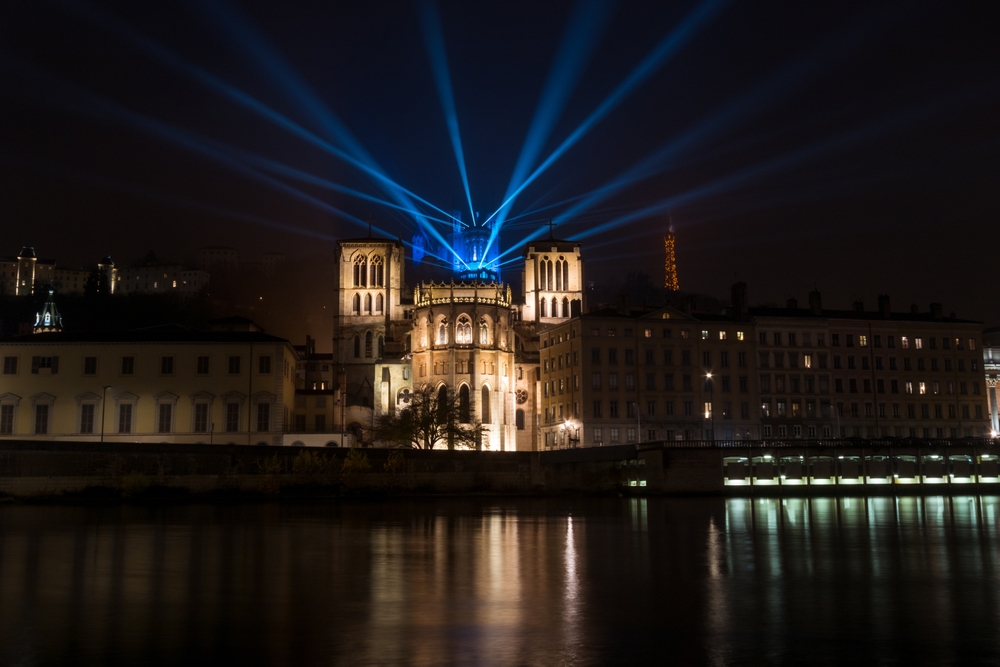
The Basilica of Notre-Dame de Fourvière is not just a tourist attraction, it is above all a living place of worship that hosts major religious celebrations and cultural events throughout the year.
Festival of Lights (8 December)
The most emblematic event linked to Fourvière is undoubtedly the Festival of Lights, which takes place around 8 December. This tradition dates back to 1852, when the people of Lyon spontaneously lit their windows with candles to celebrate the inauguration of the golden statue of the Virgin at the top of the chapel (before the construction of the current basilica). Today, this festival has become an international event, attracting several million visitors every year. The basilica itself is illuminated by spectacular lights and artistic projections that transform its façade. It’s a magical time to visit Lyon, but beware of the crowds and book your accommodation well in advance.
Masses and religious services
Masses are celebrated daily in the basilica, usually in the morning and late afternoon. On Sundays and major religious feast days, solemn masses with Gregorian chant and organ are held. The basilica’s Cavaillé-Coll organ, inaugurated in 1879, offers exceptional concerts during certain celebrations. To find out the exact times of services, visit the basilica’s website or contact the sanctuary directly.
Pilgrimages
Fourvière remains a major Marian pilgrimage site in France. Several diocesan and regional pilgrimages take place there every year, particularly on the major Marian feasts such as the Assumption (15 August) and the Immaculate Conception (8 December). These gatherings can bring together several thousand faithful from all over France and Europe.
Concerts and cultural events
Throughout the year, the basilica and its crypt host concerts of sacred music, classical music and choral singing. The exceptional acoustics and majestic setting make these events very popular with music lovers in Lyon. The Nuits de Fourvière, a major summer festival that takes place in the neighbouring ancient Roman theatre from June to July, also livens up the area with a variety of shows (theatre, dance, concerts).
Anecdotes and curiosities about the Basilica of Fourvière
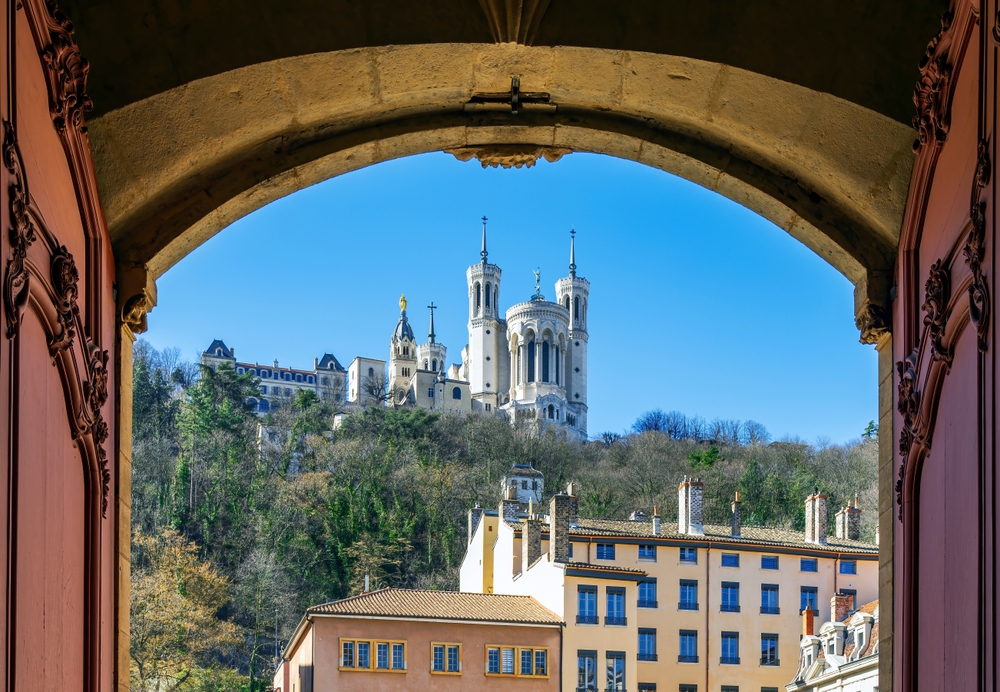
The Basilica of Notre-Dame de Fourvière is full of anecdotes and unusual details that enrich the visit and bear witness to its fascinating history.
The nickname “the upside-down elephant
The people of Lyon affectionately nickname their basilica “the upside-down elephant” because of its distinctive silhouette seen from afar: the four towers resemble the legs and the central dome the imposing mass of the pachyderm. This mischievous nickname in no way diminishes the affection that the locals have for this monument, which is an integral part of Lyon’s identity.
The vow of 1643
Long before the 1870 vow that led to the construction of the current basilica, the aldermen of Lyon had already made an initial vow in 1643 to protect the city from the plague that was ravaging the region. They pledged to pay homage to the Virgin Mary every year on 8 September if the epidemic spared Lyon. As the city was spared, this vow was kept for centuries and is one of the foundations of Marian devotion in Lyon.
The four cardinal virtues
As mentioned above, the basilica’s four towers symbolise the cardinal virtues: Prudence, Temperance, Strength and Justice. This symbolism is also reflected in the interior decoration, with allegorical representations of these virtues in various parts of the building, inviting the faithful and visitors to reflect on moral and spiritual matters.
The hidden crypt
Few visitors know it, but beneath the publicly accessible crypt of Saint-Joseph lies an even deeper crypt, which is generally closed to visitors. This underground space houses meeting rooms and technical facilities. Access is sometimes granted on special occasions, such as Heritage Days or special events.
Pope Pius IX and the foundation stone
The first stone of the basilica was blessed by Pope Pius IX himself in 1869, although he never physically came to Lyon. The stone was sent to Rome to receive the papal blessing, then solemnly brought back to Lyon to be laid on 7 December 1872. This symbolic gesture testifies to the importance attached to this project by the Catholic Church at the time.
Mosaics: a titanic task
The 6,000 square metres of mosaics that adorn the interior of the basilica took more than 12 years to complete, and involved millions of tiny tesserae of glass and stone. Charles Lameire’s workshop employed dozens of craftsmen to create this masterpiece. Some of the mosaics contain details so fine that they can only be seen through binoculars, testifying to the virtuosity of the mosaicists.
In conclusion, the Basilica of Notre-Dame de Fourvière is the embodiment of Lyon’s rich history, architecture and spirituality. From its eventful history to its exceptional architecture, from its dazzling mosaics to its incomparable panoramic view over the city, this monument offers a complete visitor experience that will delight all types of visitor. Whether you’re a believer or simply curious to discover one of France’s most beautiful religious buildings, Fourvière promises to be an unforgettable experience. To make the most of this discovery and explore all the treasures of the capital of Gaul, don’t forget to download the Navaway app, which will guide you step by step through Lyon’s 26 must-see sites, with fascinating audio commentaries and intuitive interactive navigation.
Frequently asked questions
Is a visit to Fourvière Basilica free?
Yes, admission to the Basilique Notre-Dame de Fourvière is completely free. You can visit the upper church, the Saint-Joseph crypt and the panoramic esplanade without having to buy a ticket. There is only a charge for special guided tours (classic discovery tour, unusual roof tour).
How long does it take to visit the Basilica?
For a complete visit to the basilica, including the upper church, the crypt, a pause on the esplanade to admire the panorama and a walk in the Rosary gardens, allow around 1? to 2 hours. If you opt for a guided tour, allow 2? to 3 hours in total.
What’s the best way to get to Fourvière?
Funicular F2 (nicknamed “la ficelle”) is the quickest and most practical way to get to the Basilica. It leaves from Vieux Lyon station (metro line D) and takes you directly to the Fourvière stop in just a few minutes. It’s also a little attraction in itself, and part of the Lyon experience!
Is it possible to climb to the top of the basilica’s towers?
Access to the towers is only possible as part of the unusual tour of the roofs and upper parts, which must be booked in advance with the Lyon Tourist Office. This guided tour, which lasts around 1? hours, takes you behind the scenes of the basilica and gives you access to areas that are usually closed to the public, with spectacular views over Lyon.
Are there masses in the basilica?
Yes, masses are celebrated daily at the Basilique de Fourvière. There is generally a morning mass and a late afternoon mass on weekdays, with extended times at weekends and on religious festivals. For precise times, visit the Basilica’s official website or contact the shrine directly.
Is the basilica accessible to people with reduced mobility?
Yes, the basilica has a lift located on the left wing of the building, providing access to the upper church and the crypt from the car park. The F2 funicular is also wheelchair accessible. Please contact the Basilica reception desk before your visit if you have any special needs.
Can I take photos inside the basilica?
Yes, photographs without flash are permitted inside the basilica for personal use. However, during religious services and celebrations, please do not photograph out of respect for the praying faithful. The use of tripods is prohibited. You may photograph freely on the outdoor esplanade.
What dress is required to visit the Basilica?
As this is an active place of worship, proper and respectful dress is required. Avoid short shorts, tank tops with thin straps, beachwear or any inappropriate clothing. Bring something to cover your shoulders if necessary. This rule applies to both men and women.
What’s the best time of day to visit Fourvière?
To avoid the crowds, it’s best to visit early in the morning when it opens, or late in the afternoon on weekdays. If you want to photograph the panorama in the best light, come about an hour before sunset. To enjoy the special atmosphere of the Fête des Lumières, visit the site on 8 December, but be prepared for very large crowds.
Is there a car park near the basilica?
Yes, there is a pay car park in the immediate vicinity of the basilica (Parking de la Basilique de Fourvière), but spaces are often limited, especially in high season. The charge is around €2 per hour. Other car parks are available further down the hill, notably near the Saint-Just funicular. However, we strongly recommend using public transport to get to Fourvière.
200 audioguided tours for cities all around the world
Download